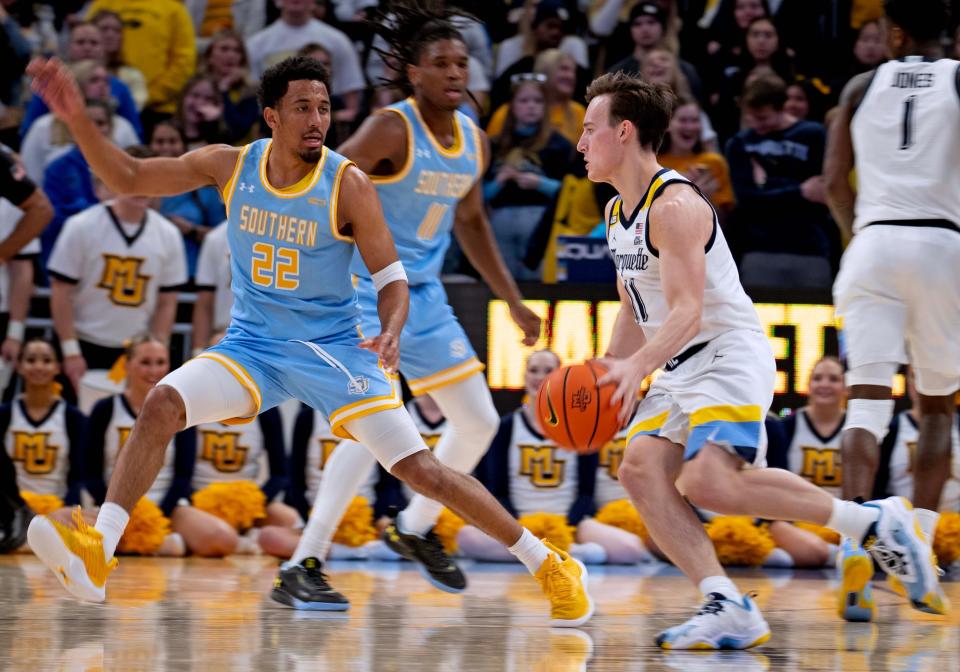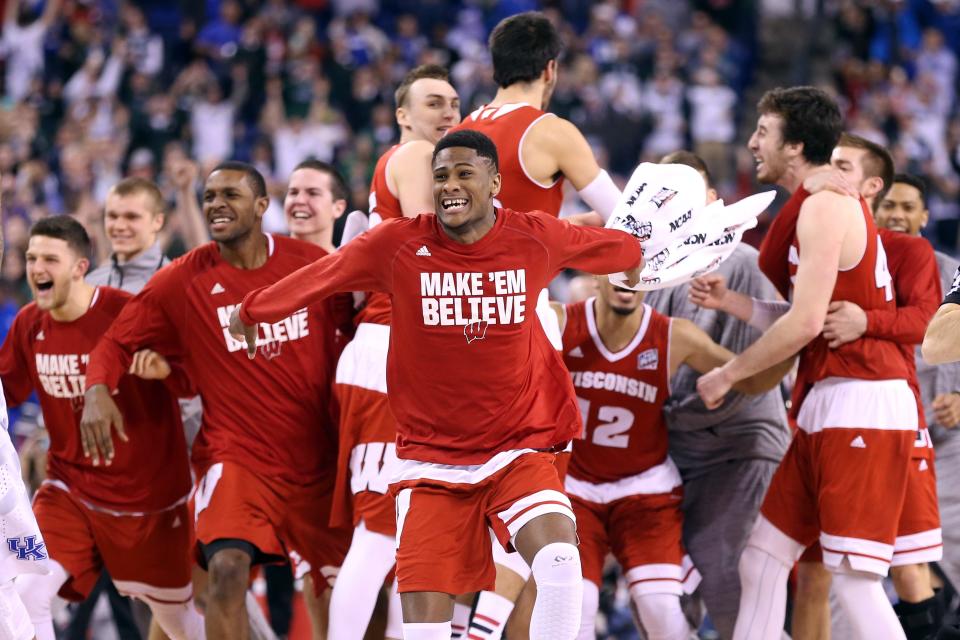Marquette's offense is elite. Can it get even better? Recent Wisconsin team may offer clues
The third-ranked Marquette men’s basketball team has hopes of making it to the Final Four this season in Glendale, Arizona.
The last team from the state to make it that far in the NCAA Tournament was the University of Wisconsin in the 2014-15 season, when the Badgers shocked an undefeated Kentucky team in the semifinal and then lost to Duke in the championship game despite holding a nine-point lead in the second half.
That UW squad finished 36-4 behind one of the best offenses in recent college basketball memory. According to KenPom.com, the authority on college hoops metrics, the Badgers had an adjusted offensive efficiency of 129 points per 100 possessions. That is the best in KenPom’s database, which dates back to 1999. Only Villanova’s mark of 127.8 in its championship season of 2017-18 has come close.
This season’s MU team also boasts an highly calibrated offense. Heading into Saturday’s game at UW (5-2), the Golden Eagles (5-1) have an adjusted offensive efficiency of 119.9, which ranks seventh in the country.
MU’s offense has been elite in the small sample of six games, but it feels like the Golden Eagles could push their efficiency even higher.
“There’s so many things we can do better,” MU head coach Shaka Smart said on Thursday. “There’s a lot of things we emphasize with our guys.
“I think one of the real challenges, and this is a good thing, is striking a balance between … we got two, three guys if you count Oso (Ighodaro along with guards Kam Jones and Tyler Kolek) at his position that are elite offensive playmakers. But there’s five guys in the game.
“We could go at one end of the spectrum that says those guys have to have the ball all the time on every play. No one can try to make a play but them. Well, that doesn’t really fit with our overall way of what we’re about.
“But at the same time, in last year’s Wisconsin game, Kam Jones got it going in the second half. He was rolling there, he was getting to the basket, he was getting to foul line, he was scoring. When that happens, we need to continue to improve our recognition and our understanding that, hey, it makes sense for the ball to get back to No. 1. So that’s a balance that we’ll continue to strike, and I think our guys are making progress.”
It would take a big leap to get MU in the stratosphere of UW’s 2014-15 season, but here is a closer look at two of the best offenses this state has seen recently.

Similarities between MU and UW in 2014-15
The biggest similarity between the teams is that both squads brought back the majority of talent from teams that were already highly efficient. The players and coaches were already familiar with strengths and weaknesses and there already existed a comfort level of playing together.
The Golden Eagles lost only NBA first-round pick Olivier-Maxence Prosper from the rotation on a team that finished seventh in adjusted offensive efficiency at 119.1, giving MU a minutes continuity of 78.8%.
The Badgers had a minutes continuity of 71.9%, with only Ben Brust graduating from the 2013-14 team that reached the Final Four behind an offensive efficiency mark of 122.
The biggest trademark of any efficient basketball team is limiting turnovers, and MU has been better at that this season. After coughing the ball up on 15.3% of its possessions last season, the Golden Eagles have shaved that turnover percentage down to 12.2, a top-10 mark in the country.
“They have done a good job taking care of the ball and it starts with the point guard (Kolek)," said UW coach Greg Gard, who was an assistant under Bo Ryan on the 2014-15 team. "And Kam Jones is 19 to 3 on assists to turnovers.
“That tells me they make good decisions ... Their ability to take care of it is one of the things we emphasize here as well. And when you do, obviously you have more opportunities offensively.”
UW was the best team in the nation at not turning the ball over in 2014-15 with a 12.4% turnover percentage.
Where MU is struggling on offense this season is kind of similar to UW's less-than-stellar traits in 2014-15.
According to Synergy Sports numbers provided by MU blog Paint Touches, the Golden Eagles are averaging just .93 points per shot on their unguarded catch-and-shoot jump shots, classified as “poor” in Synergy’s database. Those attempts make up 11.6% of MU’s shot diet.
That area is where MU can significantly boost their efficiency by knocking down open jumpers, especially three-pointers. Interestingly, the Golden Eagles are shooting an “excellent” 1.10 points per shot on guarded jumpers, according to Synergy.
“We’re leading the country in the distance between the shooter and the defender on our three-point shots,” Smart said. “That’s a good thing, trust me, I’ve been on teams where we’ve been on the opposite.
“So over the course of time, what that does is it allows you to get the shots you practice. Now game shots are not the same as practice shots, for a variety of reasons. But if you can have that type of separation, you’re going to feel good about your guys that put in a lot of reps, put in a lot of hours working on their shooting.”
MU is also averaging .70 points per shot on dribble jumpers, a "below average" mark on Synergy, though those attempts only make up 4.7% of shooting possessions.
Stevie Mitchell, Sean Jones and Chase Ross have combined to shoot 9 for 50 on three-pointers over the six games. Boosting their percentages would unlock more efficiency.
“I love the looks we’re getting,” Kolek said. “Some of the guys aren’t shooting the ball well, but they’re good shooters.
“And good shooters make shots in the end. We always like to say that the water evens out. So if we’re not making them now, we’re going to make them at some point. So we’ll just keep on shooting them and see what happens.”
Where the Badgers struggled in terms of their shot diet in 2014-15 was on guarded catch-and-shoot jumpers, which, per Synergy, was “average” at 0.98 points per shot.

Differences between MU and UW in 2014-15
The obvious difference between the teams is in tempo.
The speedy Golden Eagles like to push the ball up the court and their games average 72.2 possessions.
The Badgers’ games only averaged 61.1 possessions, a mark that was near the bottom of NCAA Division 1 teams. UW’s average possession was 7.2 seconds longer than MU’s this season.
In 2014-15, the Badgers often went away from the swing offense in favor of hunting mismatches with future NBA players Frank Kaminsky and Sam Dekker. Almost 14% of UW’s possessions were classified as post-ups and over 11% as isolations. MU is under 5% this season in both those categories.
The Golden Eagles operate much more in transition: 17% of their possessions. The Badgers were in transition about 7% of possessions.
“It starts with the players," Gard said. "And their ability to score in transition. They can put pressure on you that way as well.”
There are a lot of ways to efficient basketball.
“For everybody else, efficiency is how many shots you make out of how many shots you take, points per possession and stuff like that,” Kolek said. “Efficiency for us is our process and how we’re getting to those shots.
“The type of shots that we want. If we’re coming down the floor with pace, getting into our halfcourt sets with pace and getting the shots that we want to get, then that’s efficient.
“If we’re coming down the floor slow, maybe taking some bad shots, even though we’re making them and we could be quote-unquote efficient, we’re not being efficient the way we want to be. So just kind of hammering home our cultural principles, our offensive principles and stuff like that really helps us.”
Jeff Potrykus of the Journal Sentinel staff contributed to this report
This article originally appeared on Milwaukee Journal Sentinel: Marquette Golden Eagles have one of most efficient offenses in nation

